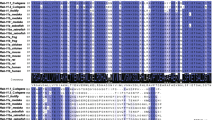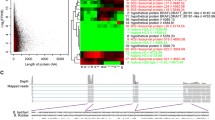Abstract
Vertebrate RACK1 plays a key role in embryonic development. This paper described the cloning, phylogenetic analysis and developmental expression of AmphiRACK1, the RACK1 homologous gene in amphioxus. Phylogenetic analysis indicated that amphioxus RACK1 was located at the base of vertebrate clade. AmphiRACK1 expression in lithium-treated embryos was also examined. During embryonic development, AmphiRACK1 was expressed strongly in cerebral vesicles, neural tubes and somites. In lithium-treated embryos, the segmental expression of AmphiRACK1 in somites became blurry and decreased. Its expression in cerebral vesicles and neural tubes was also weaker or disappeared. In the adult animal, AmphiRACK1 transcripts were detected in the epithelium of midgut diverticulus and gut, wheel organ, gill blood vessels and testis.
Similar content being viewed by others
References
Jaken S. Protein kinase C isoenzymes and substrates. Curr Opin Cell Biol, 1996, 8: 168–173
Gallicano G I, Yousef M C, Capco D G. PKC: a pivotal regulator of early development. Bioassays, 1997, 19: 29–36
Mochly-Rosen D, Khaner H, Lopez J. Identification of intracellular receptor proteins for activated protein kinase C. Proc Natl Acad Sci USA, 1991, 88: 3997–4000
Chang B Y, Conroy K B, Machleder E M, et al. RACK1, a receptor for activated C kinase and a homolog of the beta subunit of G proteins, inhibits activity of src tyrosine kinases and growth of NIH 3T3 cells. Mol Cell Biol, 1998, 18: 3245–3256
Liliental J, Chang D D. Rack1, a receptor for activated protein kinase C, interacts with integrin beta subunit. J Biol Chem, 1998, 273: 2379–2383
Rodriguez M M, Ron D, Touhara K, et al. RACK1, a protein kinase C anchoring protein, coordinates the binding of activated protein kinase C and select pleckstrin homology domains in vitro. Biochemistry, 1999, 38: 13787–13794
Yarwood S J, Steele M R, Scotland G, et al. The RACK1 signaling scaffold protein selectively interacts with the cAMP-specific phosphodiesterase PDE4D5 isoform. J Biol Chem, 1999, 274: 14909–14917
Hermanto U, Zong C S, Li W, et al. RACK1, an insulin-like growth factor I (IGF-I) receptor-interacting protein, modulates IGF-I-de-pendent integrin signaling and promotes cell spreading and contact with extracellular matrix. Mol Cell Biol, 2002, 22(7): 2345–2365
Chen S, Dell E J, Lin F, et al. RACK1 regulates specific functions of Gbetagamma. J Biol Chem, 2004, 279: 17861–17868
Kwon H J, Bae S, Son Y H, et al. Expression of the Xenopus homologue of the receptor for activated C-kinase 1 (RACK1) in the Xenopus embryo. Dev Genes Evol, 2001, 211: 195–197
Ashique A M, Kharazia V, Yaka R, et al. Localization of the scaffolding protein RACK1 in the developing and adult mouse brain. Brain Res, 2006, 1069(1): 31–38
Hui C L, Eric C S, Walter D S, et al. Evidence for a role of protein kinase C in FGF signal transduction in the developing chick limb bud. Development, 2001, 128: 2451
Klein P S, Melton D A. A molecular mechanism for the effect of lithium on development. Proc Natl Acad Sci USA, 1996, 93: 8455–8459
Zhen X, Torres C, Friedman E. Lithium regulates protein tyrosine phosphatase activity in vitro and in vivo. Psychopharmacology (Berl), 2002, 162: 379–384
Horstadius S, Josefsson L. Endogenous morphogenetic substances of sea urchin influencing the larval differentiation. Acta Embryol Exp (Palermo), 1973, 1: 71–88
Kao K R, Elinson R P. The entire mesodermal mantle behaves as Spemann’s organizer in dorsoanterior enhanced Xenopus laevis embryos. Dev Biol, 1988, 127: 64–77
Stachel S E, Grunwald D J, Myers P Z. Lithium perturbation and goosecoid expression identify a dorsal specification pathway in the pregastrula zebrafish. Development, 1993, 117: 1261–1274
Linask K K, Ludwig C, Han M D, et al. N-cadherin/catenin-mediated morphoregulation of somites formation. Dev Biol, 1998, 202: 85–102
Yasui K, Li G, Wang Y, et al. Beta-catenin in early development of the lancelet embryo indicates specific determination of embryonic polarity. Dev Growth Differ, 2002, 44: 467–475
Holland L Z, Panfilio K A, Chastain R, et al. Nuclear beta-catenin promotes non-neural ectoderm and posterior cell fates in amphioxus embryos. Dev Dyn, 2005, 233(4): 1430–1443
Tung T C, Wu S C, Tung Y F. The development of isolated blastomere of amphioxus. Sci Sin, 1958, 7: 1280–1320
Huang X, Wang L, Zhang H. Expression pattern of HMGB gene in the development of amphioxus, Branchiostoma belcheri tsingtauense. Int J Dev Biol, 2005, 49: 43–46
Holland P W. Whole mount in situ hybridization to amphioxus embryos. Methods in Mol Biol, 1999, 97: 641–644
Grunewald-Janho S, Keesey J, Leous M, et al. Nonradioactive in situ Hybridization Application Manual. 2nd edition. Mannheim: Boehringer Mannheim GmbH Press, 1996
Neer E J, Schmidt C J, Nambudripad R, et al. The ancient regulatory-protein family of WD-repeat proteins. Nature, 1994, 371: 297–300
Vani K, Yang G, Mohler J. Isolation and cloning of a Drosophila homolog to the mammalian RACK1 gene, implicated in PKC-mediated signalling. Biochim Biophys Acta, 1997, 1358: 67–71
Dehghani H, Hahnel A C. Expression profile of protein kinase C isozymes in preimplantation mouse development. Reproduction, 2005, 130(4): 441–451
Liang K, Lin Y, Zhang Y, et al. Developmental expression of amphioxus GABAA receptor-associated protein-like 2 gene. Dev Genes Evol, 2004, 214: 339–341
Huang X, Zhang W, Zhang H. Phylogenetic analysis and developmental expression of thymosin-beta 4 gene in amphioxus. Dev Genes Evol, 2005, 215(7): 364–368.
Kitazawa C, Takai K K, Nakajima Y, et al. LiCl inhibits the establishment of left-right asymmetry in larvae of the direct-developing echinoid Peronella japonica. J Exp Zoolog A Comp Exp Biol, 2004, 301: 707–717
Author information
Authors and Affiliations
Corresponding authors
Additional information
These authors contributed equally to this work
Supported by the National Natural Science Foundation of China (Grant Nos. 30270693 and 30570967)
Rights and permissions
About this article
Cite this article
Huang, X., Zhang, W., Li, X. et al. Developmental expression of amphioxus RACK1 . SCI CHINA SER C 50, 329–334 (2007). https://doi.org/10.1007/s11427-007-0025-1
Received:
Accepted:
Issue Date:
DOI: https://doi.org/10.1007/s11427-007-0025-1




